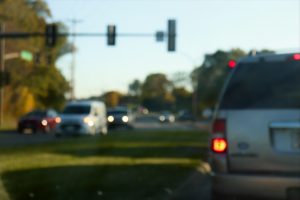The Road Always Traveled: How Technology is Improving Transportation Safety
Author: Sarah Hays
Author: Sarah Hays
While most people drive or ride in a vehicle every day, the dangers of the road are often easily dismissed. But in reality, the dangers are many, according to Jonathan Wood, assistant professor in Civil, Construction and Environmental Engineering (CCEE) at Iowa State University (ISU).
“One of the issues, not just in the United States, but around the world, is that people are always getting in crashes,” Wood said. “When you get in a crash, there is a risk of injury and even death. With updated vehicle technology, we can hopefully reduce that risk.”
Wood has spent many years researching road and transportation safety. Before his time at ISU, he worked at Ford, developing and leading a research team that did real-world data analysis. Not only did he analyze the external safety in transportation systems, but he also did a lot of work with vehicle technology, such as lane assist and other safety upgrades that are often found in models of newer cars.
Throughout Wood’s time at Ford, he found that new vehicle technology can be a valuable tool to improve transportation safety.
Now, at ISU, Wood’s research projects consist of analyzing police report crash data. Wood is analyzing transportation data with three goals in mind: preventing crashes, reducing the severity of crashes and lowering the costs of roadway and roadside incidents.
“My research does several things,” Wood said. “We are trying to prevent crashes if we can and reduce the severity when they do occur. That reduces the risk of getting hurt and helps with our third goal – lowering costs. Not only are there physical costs associated with injuries, but there are also other costs, such as insurance.”
There are a few methods to reaching these three goals that Wood has been researching. And just like at Ford, Wood realized that new technology plays a significant role in achieving these goals.
“There are three ways to prevent crashes: intervening with the human behavior that leads to crashes, making changes to the roads and roadside, and helping drivers be more educated and understanding of new driver technologies,” Wood said.
Wood has been digging into these solutions in several ways. Data Analysis is one of Wood’s most prominent research methods. Through his analyses, he can log trends and use that information to see where the faults of transportation rise to the surface.
“I use different data sources, whether that is police-reported crash data, crash reconstruction data, or where expert teams go and reconstruct what happened, conduct interviews, and get information from vehicles,” Wood said. “After gathering the data, I use a variety of statistical methods to holistically try and solve the challenges here and communicate them in a way that people can understand, so people like policymakers can use this information to help save lives and reduce injuries and costs.”
 By analyzing the problems, Wood, and other engineers, can discover how to jumpstart the solution.
By analyzing the problems, Wood, and other engineers, can discover how to jumpstart the solution.
“Looking back on the numbers and gaining a true understanding of what is causing crashes in the first place allows engineers and policymakers to say, ‘Okay, what are things that we can potentially do to intervene and prevent these crashes from happening,’” Wood said.
According to Wood, one of the most impactful transportation trends right now is the speed at which vehicle technology is accelerating. More specifically, roads in the past have been built with unique features to protect drivers and passengers, such as rumble strips or other physical attributes – but they might not be necessary in the future.
“Some of the traditional things that engineers do on the roadway to help prevent crashes are likely changing their effectiveness due to new car technologies,” Wood said. “For example, rumble strips on the roadway give you a noise warning if you start to drive over them, and that helps you come back to the lane and stay in it. But how useful are rumble strips if we have lane centering technologies that already help you stay in the lane?”
New technologies, like lane centering assist, can potentially take over the role of rumble strips. And if that were to happen, a lot of the money that goes towards rumble strips, or other external protection devices that are no longer needed, can be used for additional roadway and roadside protection.
“Because lane assist technologies replace what rumble strips do, investing money in rumble strips may not be the best use of funds in the future,” Wood said. “Now, those funds can be used for something else to prevent crashes. It is all about the optimization of resources to improve safety.”
If new technology cancels out the need for roadside safety elements, engineers like Wood can reallocate funding to develop more safety precautions on the road and in vehicles.
“With the way technology is advancing, there are a lot of these things we need to think about futuristically so we can understand the technology and use it to our advantage,” Wood said.
The future of modern technology is ever-changing, bringing new opportunities to improve transportation safety. And with improvement, people like Wood can help create a safer ride for everyone on the road.